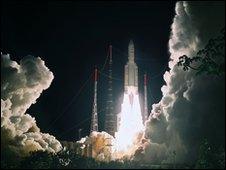Europe studies new rocket options
- Published

The Ariane 5 is regarded as reliable but is expensive to operate
The European Space Agency (Esa) has asked a consortium led by EADS Astrium to investigate what sort of rocket should succeed the Ariane 5.
The new vehicle, dubbed simply the Next Generation Launcher (NGL), would not come into service before 2025 - if ever it were developed.
Although highly regarded for accuracy and reliability, the Ariane 5 is expensive to operate.
Lower costs will be critical in maintaining a competitive position.
The 15-month study will report in time for Esa's next ministerial council in 2012.
If member states were to approve a successor, its development would cost them many hundreds of millions of euros, quite probably billions.
"The development of a new launcher involves creating the technologies of tomorrow, whilst minimising development costs and ultimately operating costs," said Astrium Space Transportation CEO, Alain Charmeau. "It's the adventure of a lifetime."
EADS Astrium is the current prime contractor on the Ariane 5.
Introduced in 1996, the European workhorse has now flown more than 50 missions.
Year on year, it launches about half the world's large telecoms satellites.
Current concepts for a successor point to a more modular design.
It might have two or three stages and be capable of launching a range of payloads, from three tonnes to eight tonnes, into a geosynchronous orbit some 36,000km above the Earth.
But the NGL would also have to fly a range of different missions, including low-Earth polar orbits favoured by many environmental monitoring spacecraft.
Because of its design, the Ariane 5 has to launch two medium-sized satellites or one giant platform to make best use of its performance.
The NGL on the other hand would be capable of launching a single medium-sized satellite in its simplest configuration, or could sport additional strap-on boosters if required to loft a larger platform.
The Astrium study will consider various design options, covering the different types of propulsion, materials, structures, avionics, etc that might be incorporated into the NGL.
The director general of Esa, Jean-Jacques Dordain, said recently that Europe needed to "reflect on", and "learn lessons" from, the maiden launch of the US Falcon 9 rocket developed by the SpaceX company.
The total development costs of the Falcon 9 to its first flight in June were about half a billion dollars, SpaceX CEO Elon Musk has claimed.
The California company is currently advertising launch prices that dramatically undercut those of its competitors, including Arianespace, the firm which markets the Ariane 5.
- Published21 May 2010